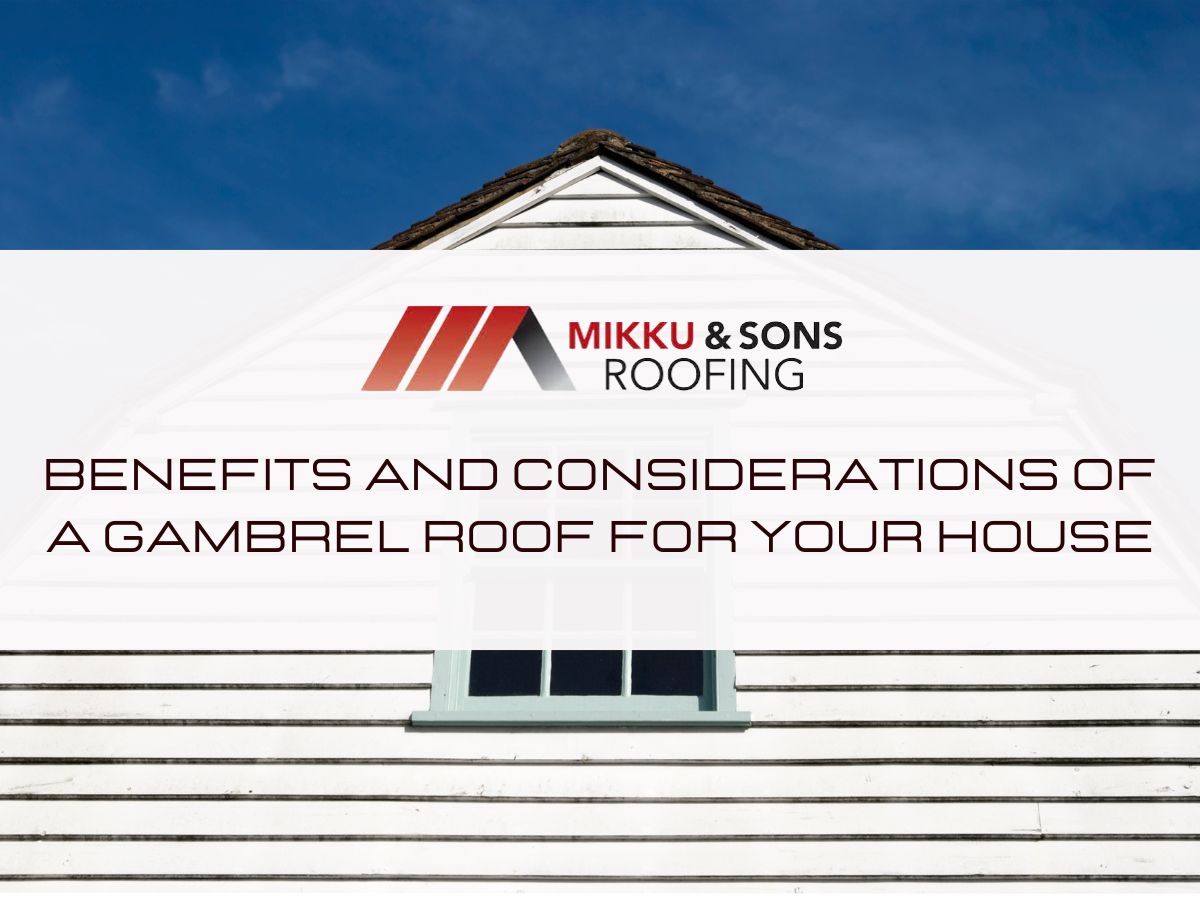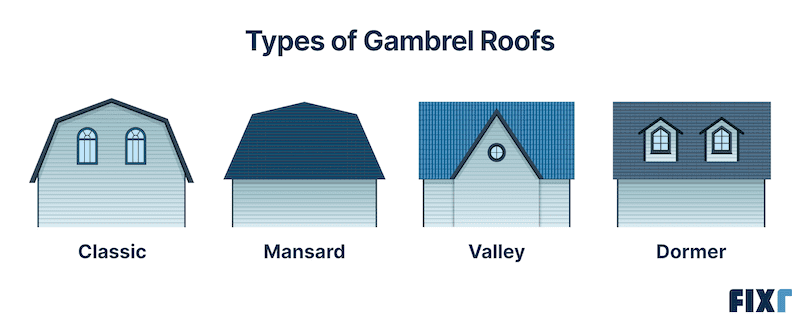

When you're thinking about your next home project one of the biggest decisions you'll face is the roof. It might not be the flashiest part of your house, but it’s one of the most important.
The right roof can shape the way an entire house looks and feels. And one of these types is the gambrel roof.
You’ve likely seen this kind of roof before, even if you didn’t know its name. That iconic double slope, the one you often spot on old barns or charming countryside homes, has been around for ages.

There’s something about the shape of a gambrel roof that instantly catches the eye. It doesn’t follow the usual lines you see on most homes, which gives it a unique presence.
From the street, it gives your house a distinct profile, one that often sparks curiosity or even compliments from visitors or neighbors.
A gambrel roof is made using two different slopes on each side. The upper section starts at a shallow angle, while the lower section drops more steeply. This break in slope creates more headroom inside and forms that classic silhouette that often gets mistaken for a barn roof at first glance.
The internal framework relies on a series of trusses or rafters that support the change in pitch. Because of the way the weight is distributed, the design can open up the space beneath it, which can make it easier to build an attic or a loft-style second floor.
The gambrel roof goes back hundreds of years and was first used in colonial homes and Dutch-inspired architecture. The design solved a simple problem: how to get more usable space without adding more stories.
It worked so well that it never really went out of style. Today, this roof design still shows up in all kinds of homes, from cozy countryside retreats to updated suburban builds.
Homeowners who choose this style usually aren’t just looking for something that looks different. They want something that works differently too. And in many cases, it does.
It’s easy to overlook the roof when you’re trying to make the most of your living space. Most people focus on square footage at ground level, but not above.
A gambrel roof adds extra room in a way that feels smart, not excessive. You aren’t forced to expand the foundation or add a full second floor just to squeeze in a little more living area.
The sharp lower slope combined with the gentler upper angle creates a larger and more usable upper floor. Instead of tapering off like traditional pitched roofs, this one stretches out the sides, giving you more vertical space.
That design can give you taller walls in your attic or loft area, which makes it easier to stand, walk, and furnish the space comfortably. This kind of structure works especially well when you’re trying to build in an attic bedroom, home office, or even a studio space.
It gives you more options without the construction costs of adding an entirely new level to your home.
With the added room a gambrel roof can give, you aren’t stuck with a narrow crawl space or awkward corners. The interior becomes flexible enough to shape around your needs.
It could become a full guest suite, a playroom, or just a spot where you finally have space to stretch out and focus. And because this roof opens up the interior so effectively, you might be able to skip that costly home addition you were considering.
You end up saving on materials, time, and labor while still gaining functional space that feels intentional. That kind of design choice can make a real difference when you're planning how to grow into your home instead of out of it.
Some roof styles come and go depending on trends or what the market is pushing. But a gambrel roof has a look that seems to fit no matter what year it is.
There’s a reason it’s stuck around for generations. It brings a certain charm to a home without feeling forced or overly styled.
The gambrel roof has strong roots in American architecture, especially in older colonial and Dutch-style homes. That influence still holds up today, adding a softer, more welcoming shape to a house, which makes it feel lived-in and personal.
While sharp modern angles or flat lines can feel cold to some, this design brings warmth just by the way it’s shaped. It can also break up the monotony of standard rooflines in neighborhoods where every house starts to look the same.
A home with a gambrel roof tends to catch the eye in a good way, offering a familiar shape that still feels a bit unexpected. It’s simple, but not boring.
With the right materials and finishes, the roof fits into newer builds just as well. Think wood accents, metal roofing, or clean trim lines that give it a more updated feel while keeping its original charm intact.
The versatility of this design also gives you room to play with your exterior style. It can support dormer windows, wrap-around porches, or even large picture windows without throwing off the balance of the roof.
When the weather turns rough, your roof becomes the first thing standing between you and the elements. You want something that not only holds up but actually helps your home deal with heavy rain, snow, and everything in between.
The lower portion of the gambrel roof comes in at a sharp angle, which helps move water and snow off faster. Water doesn’t have much time to sit and seep in, and snow doesn’t get the chance to pile up too heavily before gravity takes over.
That sloped design can reduce the chances of leaks, ice dams, and the kind of water damage that turns into bigger repairs down the line. Even in climates where winter hits hard, this kind of roof can handle the weight better than many flatter designs.
As long as it’s built properly and kept in good shape, the structure can stay strong under pressure without requiring constant cleanup or maintenance every time it snows.
When water drains off quickly and snow doesn’t have a chance to pile up, your roof doesn't have to work as hard to stay intact. That can mean fewer repairs over the years and less strain on the materials themselves.
You also avoid issues like rot or mold in the roof deck, which often show up when moisture has nowhere to go. Good drainage helps your whole house, not just the roof.
You’re less likely to deal with leaks around windows, water pooling near the foundation, or unexpected drips showing up inside. It’s one less thing you have to worry about every time the weather turns, and that peace of mind counts for a lot.
Budget always matters, no matter how big or small the project is. When you're looking at different roof styles, the cost can add up fast, especially once materials, labor, and time start stacking together.
A gambrel roof can offer a little relief, without cutting corners where it counts.
The shape of a gambrel roof makes the most out of a relatively simple frame. Because it uses fewer support beams compared to more complex roof styles, it often cuts down on the amount of lumber needed.
And since the slopes create more room inside the roof itself, you may not need to frame out a whole separate floor to get that usable space. This efficiency also means fewer materials for the outer layer.
The surface area is often smaller than it looks, due to the angles doing the work of adding volume.
Since the gambrel design follows a predictable structure, experienced builders can usually put it together faster than more complicated or custom roof styles. That speed can translate into fewer workdays, which means fewer hours on the clock and less spent on labor overall.
It also helps that many contractors are already familiar with this design. It doesn’t require specialty skills or niche materials, so you’re not stuck hiring someone at a premium just to get the job done right.
Every design choice comes with its own set of trade-offs. A gambrel roof can offer a lot, but it’s not always the perfect fit for every home or location.
Before you start sketching plans or talking to a contractor, it’s worth thinking through a few key details that could affect your build.
Gambrel roofs work best in certain regions more than others. In areas with high winds or frequent storms, the broad, tall shape can sometimes catch more air than a low-profile roof would.
This doesn’t mean it’s a bad option in storm-prone places, but it does mean you’ll want a solid framing plan and possibly some reinforced materials to keep things secure. Moist, coastal climates can also affect how long certain roofing materials last.
If you’re using wood shingles or other natural materials, they may need extra care in areas with a lot of rain or humidity. Local weather patterns can help guide which version of a gambrel roof works best for your home.
Not every neighborhood allows for bold roof designs, especially if you live in a place with strict homeowners’ association rules or tight building codes. Some areas have height restrictions, material guidelines, or requirements that your roof fits a certain “look.”
A gambrel roof can sometimes stretch those limits depending on how it’s built. Before you commit to the design, it’s smart to check with your local planning department or builder.
The last thing you want is to fall in love with a layout and find out it doesn’t meet zoning rules or neighborhood expectations. A little research upfront can save you the hassle of changing plans mid-build.
A gambrel roof can give you more space, a unique look, and practical benefits like better drainage and potential cost savings. But it also asks for thoughtful planning, especially when it comes to climate, structure, and maintenance.
Thinking about the bigger picture can also help you narrow down your options. Gambrel roofs fall under the category of sloped roofs, but they’re just one of many types out there.
It’s helpful to step back and consider how sloped roofs in general compare to flat ones. They each come with their own pros and trade-offs, and knowing how they stack up side by side can make your decision feel a lot more grounded.
